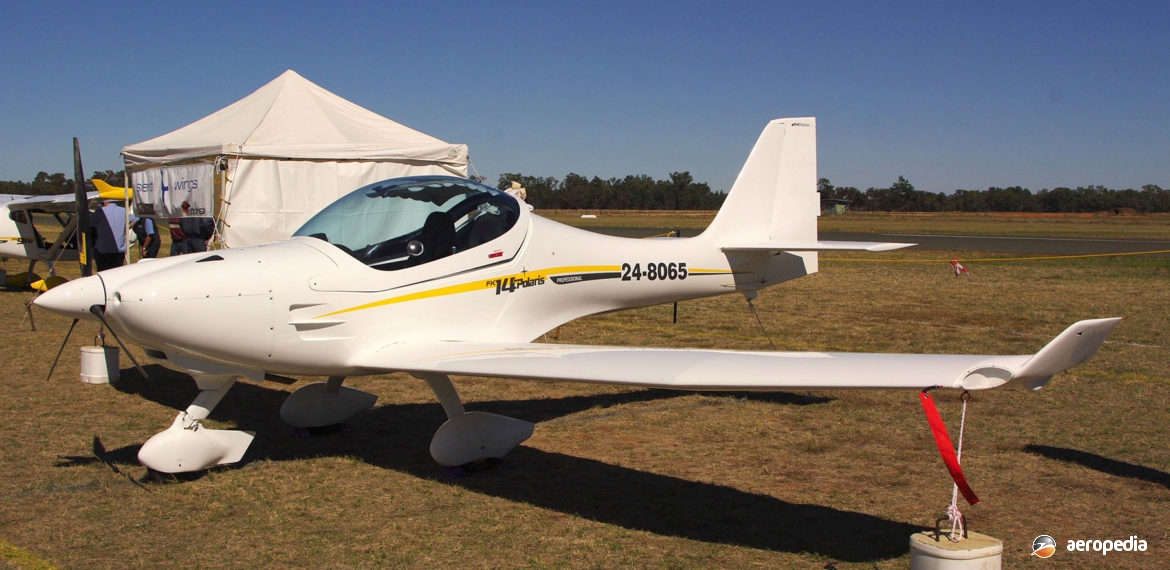Photograph:
FK Lightplanes FK-14 Polaris 24-8065 (c/n 141) at Temora, NSW in March 2013 (David C Eyre)
Country of origin:
Germany
Description:
Two-seat light sport monoplane
Power Plant:
One 75 kw (100 hp) Rotax 912 four-cylinder horizontally-opposed liquid-and-air-cooled engine
Specifications:
- Wingspan: 9.04 m (29 ft 7 in)
- Length: 5.69 m (18 ft 7 in)
- Height: [tricycle undercarriage] 2.0 m (6 ft 6 in)
- Max cruising speed: 235 km/h (146 mph)
- Initial rate of climb: 335 m/min (1,100 ft/min)
- Take-off run to clear 15 m (50 ft) obstacle: 205 m (673 ft)
- Empty weight: 284 kg (626 lb)
- Loaded weight: 520 kg (1,146 lb)
History:
B & F Technik Vertriebs GmbH was founded in 1990 by two students, Otto and Peter Funk, who set up a facility at Hofheim, later in 1995 moving to Speyer. A subsidiary, FK Lightplanes of Speyer, Germany had been building composite and metal two-seat light sport aircraft since the early 1990s and has produced a range of light aircraft, including a biplane known as the FK-14 Komet, and the FK-9 Mk 4.
Production of the airframe has taken place at Krosno in Poland, assembly and final production of the aircraft taking place in Germany. The Polaris design commenced in 1997, the wing being developed in conjunction with the University of Stuttgart using its laminar wind tunnel.
The fuselage was of fibreglass sandwich with a tubular metal frame section in the cockpit area. It had a steerable tricycle undercarriage but could be built in tricycle or tailwheel configuration. The tailplanes and ailerons were of metal, and the wing spar was carbon fibre. In the wing construction aluminium sheeting was placed over a honeycomb ribbed structure. Aluminium Fowler flaps were driven electrically. Either the Rotax 912 or 912S engine was usually installed. The series could be obtained as a kit or as a factory-completed aircraft. Production was at a rate of about four to five aircraft per month of all designs.
In 2003 the Model FK-14 [B] appeared, this having an altered swivel angle for the canopy to allow better access for tall pilots, a new nosewheel steering system integrated in the nosewheel fairing for improved aerodynamics, a stretched fuselage for improved longitudinal stability, modifications to the tailplane, and the entire wing structure built from carbon/Nomex sandwich to obtain better aerodynamics and to make repair easier. Other changes included a modified outer wing panel and wingtip to improve stall characteristics, an integrated fuel tank system in the wing with a capacity of 65 litres (14.3 Imp gals), changes to the luggage compartment behind the seats, and an optional tailwheel variant with a lower empty weight and slightly better cruising speed.
In early 2007 FK Lightplanes was obtained by Cirrus Design, the American company, in July that year announcing the FK-14 Polaris would become part of the Cirrus aircraft line, receiving some re-design, which included improved egress, a new fuel selector, a recovery parachute system, an increase in all-up weight. It has been made available as a trainer and entry level light sport aircraft.

